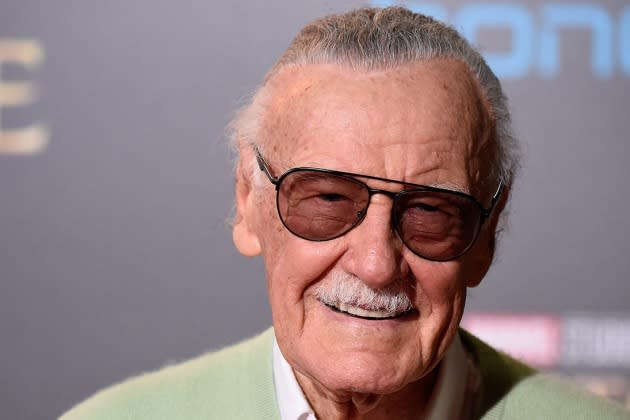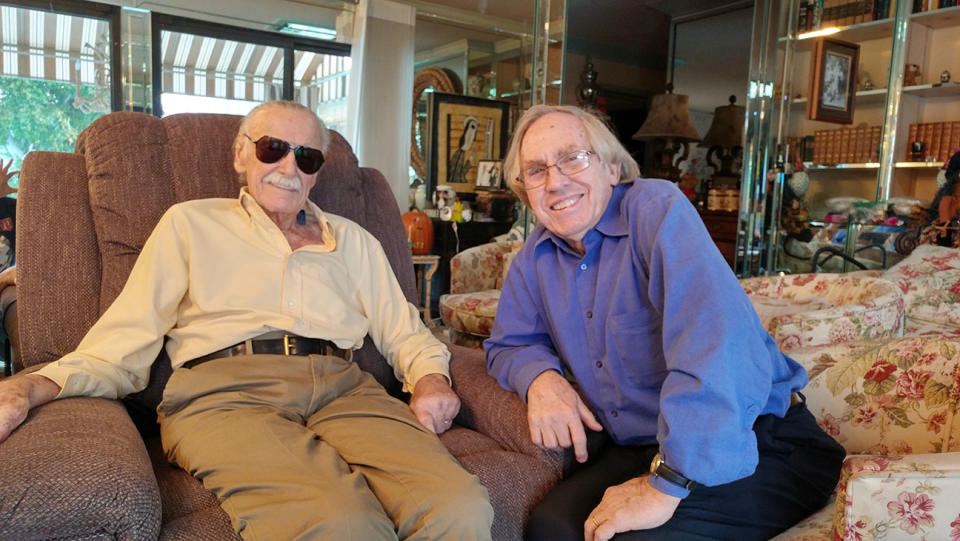Roy Thomas, Former Marvel Editor, Addresses Debate Over New Stan Lee Doc (Guest Column)
- Oops!Something went wrong.Please try again later.
- Oops!Something went wrong.Please try again later.
- Oops!Something went wrong.Please try again later.

Roy Thomas was hired by Stan Lee in 1965 and succeeded him as Marvel editor-in-chief in 1972 when Lee became the publisher. Here, Thomas examines Stan Lee, the new documentary on Disney+ that has sparked debate over who deserves primary credit for the success of the Marvel Universe and its heroes — Lee or close collaborators such as artists Jack Kirby, whose son Neil has expressed disappointment in the documentary’s sidelining of his father’s contributions.
“Stan Lee was his own greatest creation.”
More from The Hollywood Reporter
That’s a line that’s often tossed around these days — the more so since Stan died in late 2018 and isn’t around to respond in person to it — and there’s an argument to be made for it, as anyone who watches the new David Gelb documentary Stan Lee, now streaming on Disney+, can testify.
After all, a young Stanley Martin Lieber (though around age 18, not 16 as he misremembers early in the doc) did coin the name “Stan Lee” as a pseudonym with his very first story, written for Captain America Comics No. 3 around the end of 1940.
Then, beginning in the 1960s when the new “Marvel Comics Group” and its heroes erupted on the scene and gained pop-culture traction, he increasingly turned “Stan Lee” into a spokesman for comics in general, for Marvel in particular, and arguably for himself even more in particular. Stan Lee, as I knew him from mid-1965 till the end of his long life, was not a man with a fragile ego. Or, if fragile it was, it was far better shielded behind that winning smile and glib tongue than Tony Stark’s heart is behind Iron Man’s armor.
The real question, I suppose, is whether he deserved his status as the major creator of the so-called Marvel Universe.
Gelb’s documentary wisely lets Stan himself narrate his story from start to finish. Virtually the only voice we hear during its 1½-hour length that speaks more than one or two sentences in a row is Stan’s, in extended sound bites harvested from a host of TV appearances, comics convention Q&A sessions, award ceremonies, previous documentaries, and radio guest shots — enlivened by the occasional deathless line of dialogue from one of his many late-life movie cameos.
This is a refreshing way to encounter Stan the Man, and Gelb and his producers (which include Marvel Studios) are to be congratulated for letting him tell his own tale his way. By and large, the effort is successful and entertaining … and, so far as I can tell from my long association with him (which includes writing a humongous “career biography” of him for Taschen Books in the 2010s), it presents a reasonably accurate portrait of the man as he saw himself, and as the world came to see him:
As arguably the most important comicbook writer since Jerry Siegel scribed his first “Superman” story back in the 1930s…
As the creator (or at the very least the co-creator) of a host of colorful super-heroes and related comics characters…
…And as the creator (or at least the major overseer and guiding light) of a four-color phenomenon that became known as the Marvel Universe, and which formed the underlying bulwark of the now-even-more-famous Marvel Cinematic Universe, the most successful series of interconnected motion pictures in the history of that medium.
But of course he didn’t do it alone … and that’s where all the mostly ill-considered criticisms of Stan Lee’s life and work begin to kick in.
As recorded in the film, simply because he often (not always, but often) fails to credit the artists he worked with, Stan often seems to be claiming full credit for milestones, be they the powerful Hate Monger yarn in Fantastic Four No. 21 or such concepts as the Hulk and the X-Men. This is partly just a verbal shorthand, yet it is also in accordance with his expressed belief that “the person who has the idea is the creator,” and that the artist he then chooses to illustrate that concept is not. In L.A. in the 1980s (admittedly, at a time when I was not working for him), I argued that very point with him one day over lunch, maintaining that an artist who rendered and inevitably expanded that original idea was definitely a co-creator. I made no headway with my past and future employer. And clearly, when he wrote his celebrated letter, quoted in the doc, that he had “always considered Steve Ditko to be the co-creator of Spider-Man,” he was doing so only to try to mollify Steve and those who might agree with him. Later, he admitted as much.
(The funny thing is that, stretched to its logical conclusion, Stan’s argument could be marshalled to make Marvel publisher Martin Goodman, not himself, let alone himself in conjunction with Jack Kirby, the “creator” of The Fantastic Four. After all, it was Goodman who directed Stan to devise a team of super-heroes to compete with DC’s Justice League of America.)
But surely Steve Ditko, as closely paraphrased by Stan in Gelb’s film, is also wide of the mark when he states that “an idea is only an idea,” and that it was his drawing it that had made Spider-Man real. For, without the idea in the first place, the character and story events would not exist. Surely it took both men, but they are each simply too myopic to see it.
It’s certainly true that Stan doesn’t give his most talented collaborator, Jack Kirby, ample credit in every instance for his contributions to the early days of Marvel, from Fantastic Four onward. In a way, however, that’s only human nature: Stan could best remember the things he brought to the table in 1961 — just as Jack could best recall what he had done. Neither was an omniscient observer of the mind or actions of the other.
One thing is clear almost beyond argument: Lee often gave Kirby credit, both in writing and when speaking, for much that was good about The Fantastic Four and their related co-creations. The documentary records him as saying that Jack often drew a story after a plot conference that covered only the barest essentials of the storyline; in print in the comics themselves, Stan often went even further than that. You can look it up.
One seems to look in vain, alas, for any acknowledgement whatever by Jack Kirby of Stan’s value or contributions to their collaborations. And we can be pretty sure that, had Jack credited Stan thus, David Gelb and his researchers would have tracked them down and included them in the film’s soundtrack, if only to bolster their case concerning Stan’s talents. Instead, the most we get is Jack saying, when speaking of Thor, that Stan gave him the opportunity to do such a feature and that he gave it his all. Where is his admission or even suggestion that Stan’s dialogue and captions (to say nothing of his editorial guidance and his contributions to the storylines) added any value whatever to the feature?
Nowhere, that’s where.

Now, Jack Kirby had a right to his viewpoint — that he himself was the major, if not the sole, genius behind the success of the Fantastic Four, Thor, and all the rest. But that does not mean that we need to accept that viewpoint.
What is really called for, clearly, is first a documentary about Jack Kirby and his contributions to Marvel Comics — and then another one about the career of Steve Ditko. Both of those features would be potentially welcome additions to the filmic examination of Marvel. I’d be waiting eagerly in line (and online) to view either or both.
But if/when we do get full-fledged Kirby and Ditko docs, I hope they are at least as fair to the talent, contributions, and legacy of Stan Lee as Stan’s words were to the talents, contributions, and legacies of Jack Kirby and Steve Ditko.
My own voice is heard only near the end of Gelb’s documentary, but I modestly suggest that I uttered what could be taken as the final word on the controversy, when I said (referring primarily to Stan and Jack, though it could also refer to Stan and Steve) that “neither of them could have done it without the other.”
But I also believe, most sincerely, that Stan Lee was the one who had a vision of a Marvel Universe (even if he himself didn’t invent that phrase) of overlapping characters with all-too-human emotions that defined and limited their super-powers. After all, he was not just the scripter but also the editor — the man who had been placed in charge of story and art, to deliver sales for the company that became Marvel Comics. No one else had that responsibility; almost certainly, no one besides Stan was looking at the big picture, from first to last, day in and day out.
Without Stan Lee, there might have been some good stories … some splendid art … but it’s highly unlike that there would have an overarching Marvel Universe.
And David Gelb’s able marshalling of the aural evidence underscores that point.
In the end, then, I suppose I disagree with the quote with which I began this piece.
In my mind, Stan Lee was not the greatest creation of Stan Lee.
The Marvel Universe was.
***
Roy Thomas is repped by manager John Cimino.
Best of The Hollywood Reporter
Natalie Portman at Cannes: "I Need to Leave the Drama for the Screen"
Ailing ‘Superman’ Star Valerie Perrine Finally Finds Her Hero: "The Guy Should Be Sainted"

